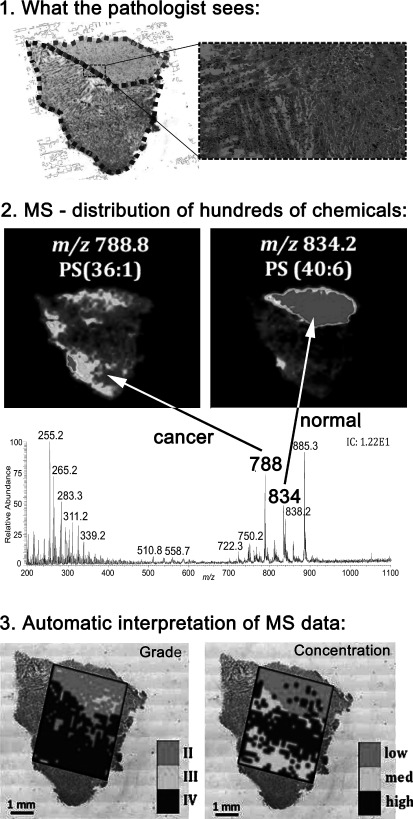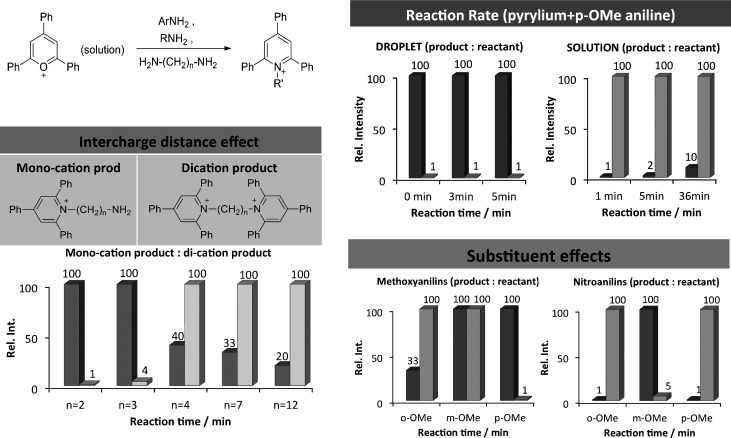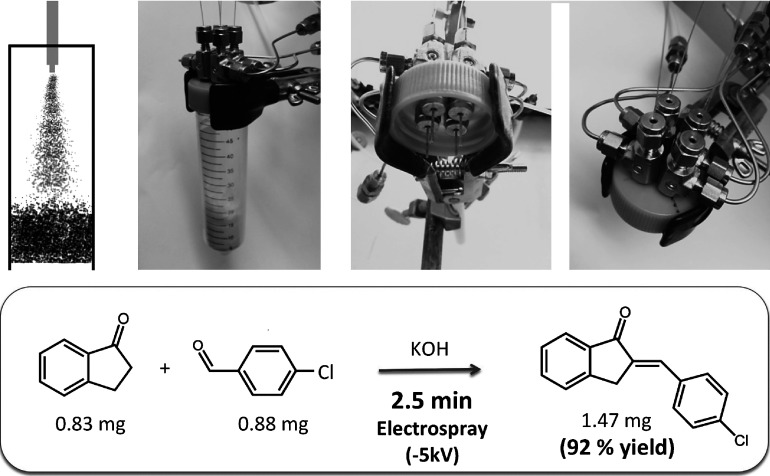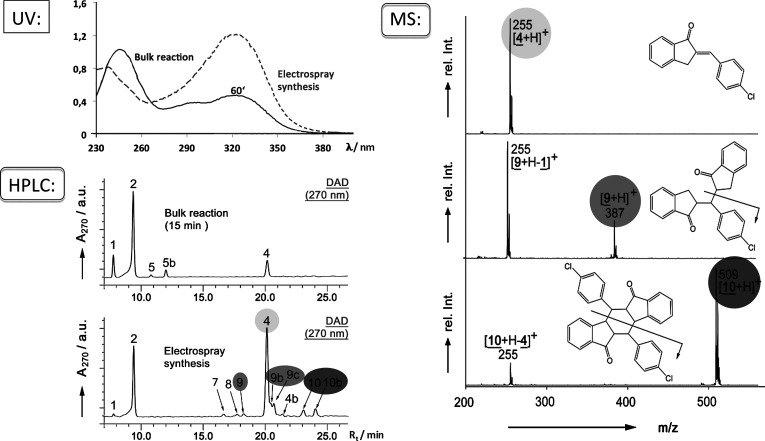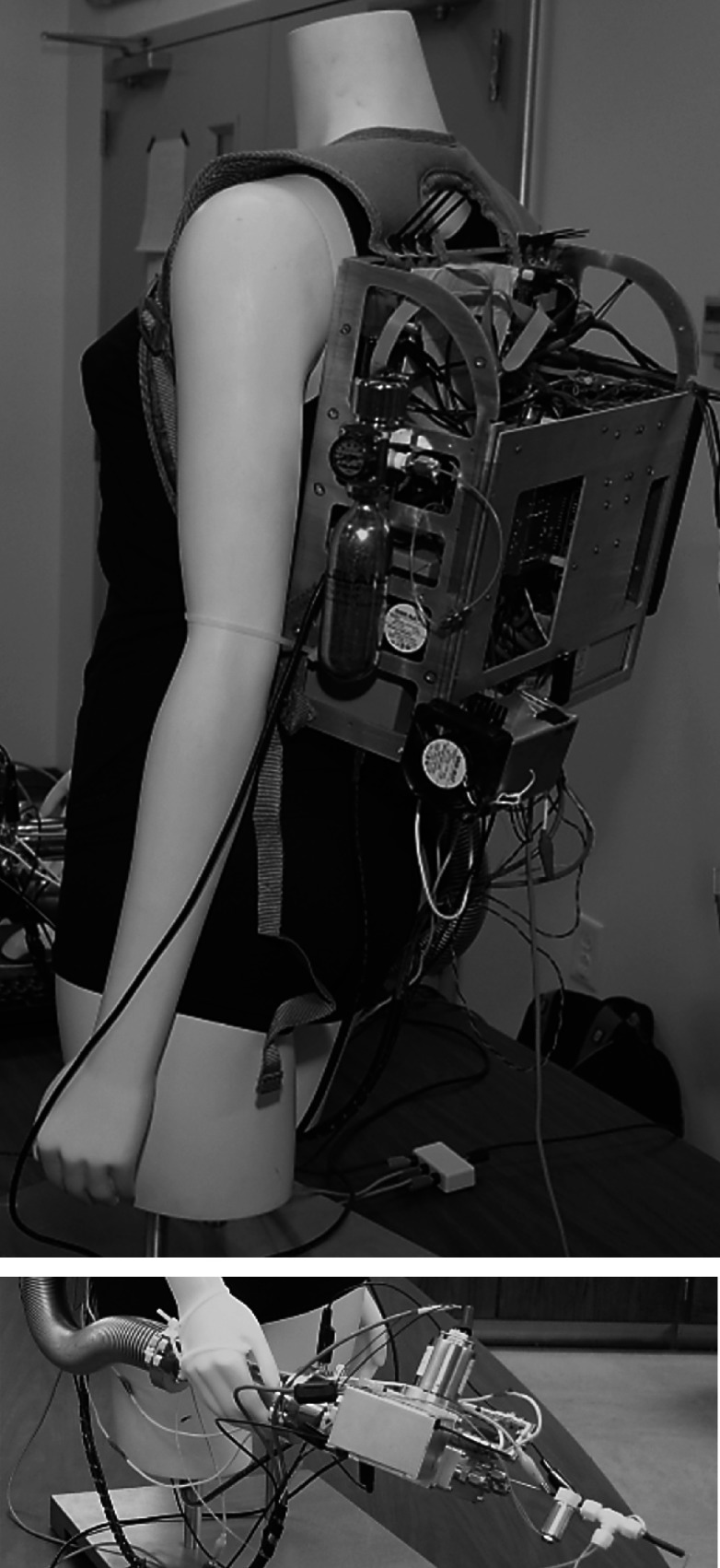Abstract
The paper has three parts, (i) a brief overview of the main achievements made using mass spectrometry across all the fields of science, (ii) a survey of some of the topics currently being pursued most activity, including both applications and fundamental studies, and (iii) some hints as to what the future of mass spectrometry might hold with particular emphasis on revolutionary changes in the subject. Emphasis is given to ambient methods of ionization and their use in disease diagnosis and to their use in combination with miniature mass spectrometers for in-situ measurements. Special attention goes to the chemical aspects of mass spectrometry, including its emerging role as a preparative method based on accelerated bimolecular reaction rates in solution and on ion soft landing as a means of surface tailoring. In summary, the paper covers the proud history, vibrant present and expansive future of mass spectrometry.
Keywords: ion chemistry, history of mass spectrometry, reaction rates, ion reactivity, mechanisms, instrumentation
Mass spectrometry may be defined, broadly, as the science and technology of ions. As such, it is a subject of enormous scope. The achievements of 20th century mass spectrometry now have come into focus. In rapid succession these include the measurement of mass/charge ratios of ions,1) the discovery of isotopes,2) and the utilization of isotope ratio measurements,3) the measurements of mass defects,4) and fundamental understanding of ionization,5) fragmentation mechanisms6) and the measurement of bond energies.7) All this was achieved in the first half of the century and was made possible by advances in instrumentation including ionization methods, detectors and most importantly mass analyzers such as double focusing sector instruments. In the second half-century, organic mass spectrometry grew rapidly, starting with applications to petroleum distillates and moving quickly to natural products, steroids, and small-molecule drugs.8) Gas chromatography/mass spectrometry was a key technology in early studies of biological systems.9) Advances in instrumentation again fueled these advances, with ion optics becoming a significant scientific technology especially in Japan.10) A preoccupation with improving mass resolution and mass range became established and different types of mass analyzers were introduced for this purpose, including time-of-flight instruments11) and quadrupole ion traps.12) This quest drove biological mass spectrometry and propelled the development of ionization methods that were increasingly successful in handling both solid samples (desorption methods)13) as well as solutions (spray methods).14) Interest in biological samples led to the coupling of the liquid chromatograph15) to mass spectrometers and to the development of the tandem mass spectrometry for complex mixture analysis.16) A highpoint of these applications in chemical analysis was the emergence—largely from within mass spectrometry—of the new subject of proteomics.17) The explicit discovery of ion/molecule reactions at mid-century18) saw the emergence of a major subject with important connections to solution-phase reactivity through solvation effects on thermochemistry and reaction kinetics.19) Unimolecular reaction kinetics,20) energy partitioning during unimolecular dissociation,21) and the dynamics of ion/molecule22) and later ion/surface collision events23) opened new fundamental areas of research with wide relevance to physical science.
The likely preoccupations and achievements of current and later 21st century mass spectrometry can only be glimpsed … “through a glass darkly.” Will the established role of mass spectrometry in chemical analysis be complemented by a significant role in synthesis—whether by soft landing of ions onto surfaces or reactive scattering? MS already has a prominent role in surface characterization but is surface tailoring by molecular modification a viable future topic? Is there a role for mass spectrometry in surgical practice?
These and other questions are taken up in this paper which is based on the closing plenary lecture, given September 21st, 2012, at the 19th International Mass Spectrometry Conference, Kyoto, Japan. The paper has three parts, (i) a brief overview of the main achievements made using mass spectrometry across all the fields of science, (ii) a survey of some of the topics currently being pursued activity in mass spectrometry, both applications and fundamental studies, and (iii) some hints as to what the future of mass spectrometry might hold with particular emphasis on revolutionary changes in the subject but without neglecting the continued evolution of topics of current high interest. Briefly, the paper covers the proud history, vibrant present and expansive future of mass spectrometry.
Mass spectrometry can be defined as the science and technology of ions. If this definition is accepted, then mass spectrometry must be seen as a subject of great depth and breadth—ions in solution, ions interacting with surfaces, reacting ions, all fall in its purvue. Alternative definitions, even that implied by the name ‘mass spectrometry’ itself are inadequate in many ways, particularly in the fact that MS is not based on electromagnetic radiation and so not a form of spectroscopy as traditionally defined. Mass spectrometry is a science that deals with one form of matter, matter that can be reacted, transformed, collected, and yes, mass analyzed. A major prediction of this paper is that the uses of mass spectrometry in chemical and material preparation and indeed in chemical synthesis will come to rival applications in chemical analysis.
PROUD HISTORY
Mass spectrometry is rooted in the work of JJ Thomson1b,24) and W. Wien.1a,25) Over the first hundred years of its history, remarkable achievements have occurred in fundamental science and technology. They fall into three well-defined areas, which have followed each other in roughly chronological order.
Fundamental physical quantities elucidated by mass spectrometry
The increase in our understanding of fundamental aspects of matter and energy, made during the first half of the 20th century using mass spectrometry, represent a major contribution to human knowledge. Knowledge was gained on atomic structure, on the connections between mass and energy, on chemical structure and on isotopes and their utilization. The subject of thermochemistry was greatly advanced. These and other similarly important advances are summarized in Table 1.
Table 1. Fundamental physical quantities determined using mass spectrometry.
| Masses of elements |
| Mass defects |
| Abundances of the isotopes |
| Ion thermochemistry |
| Thermochemical properties of neutral molecules |
Ion chemistry
Understanding of atomic structure using the methods of mass spectrometry is still an active field of research especially for unstable nuclei.26) However, fundamental studies in mass spectrometry have shifted decidedly to the chemical sciences. Some of the fundamental chemistry discovered is unique to ions, in other cases ions are simply convenient systems for study, both because they are so much more readily detected than are neutral molecules and also because ions are so easily directed and their velocities are so readily set.
Table 2 summarizes some of the mass achievements in ion chemistry over the years ca. 1930–1980, a golden age for ionic studies in vacuum. The selection of major subjects omits important topics such as development of ion/ion collisions,27) the demonstration of catalytic reaction in the gas phase,28) and the measurement of collision cross sections29) and many others.
Table 2. Some fundamental developments in ion chemistry and key references.
| Unimolecular dissociation (QET, metastable ions)20,30) |
| Ion/molecule reactions31) |
| Dynamics and kinematics (energy partitioning)32) |
| Structural characterization of elusive chemical species33) |
| Ion structures and ion spectroscopy34) |
| Cluster ions35) |
| C–C and C–H bond activation36) |
| Ionic collisions and reactions with surfaces23) |
Chemical analysis
The commercial market in mass spectrometers is based on their usefulness in chemical analysis, in the identification of particular compounds, in the elucidation of the structures of newly discovered compounds and most importantly, in the quantitative measurement of individual compounds or groups of compounds in various types of samples. The area has a strong interdependence upon the development of instrumentation including methods of making ions (ion sources) and methods of measuring ion masses (mass analyzers). Table 3 selects some of the pivotal developments in chemical analysis but we are well aware that other choices could also have been made.
Table 3. Chemical analysis by mass spectrometry.
| Elemental analysis |
| Isotope ratio measurements |
| Organic structural elucidation |
| Quantitative analysis (isotopically labeled internal standards |
| Methods: chromatography/MS; MS/MS; desorption, spray and ambient ionization |
Some further comments on the entries in Table 3 are worthwhile. The development of ionization methods and especially its realization in the spray method of electrospray ionization14a) and the desorption method of matrix assisted laser desorption37) is well known. These developments built on earlier work, including experiments using plasma desorption ionization13c,38) which demonstrated that non-volatile and thermally stable biomolecules could be successfully analyzed. This work is now little known as are the developments in molecular SIMS which included the first demonstrations of the effects of matrices39) in increasing ion yields and facilitating soft ionization.
Modern mass spectrometry depends as much on tandem (MS/MS) experiments as it does on MALDI and ESI ionization. The use of MS/MS for mixture analysis dates to the late 1970s16a) and the use of reversed sector MIKES instrumentation but it was rapidly adapted to triple quadrupoles40) and then to ion traps.41) The development of complex hybrid instruments followed and has continued with the commercial introduction of various types of multi stage MS instruments.42) The various types of multiple-stage MSn experiments have been rationalized including multiple reaction monitoring MRM43) and single reaction monitoring (SRM) experiments, lately so important in biological mass spectrometry.44) We conclude this historical with a listing of 10 singular achievements in the history of mass spectrometry (Table 4). The list does not include developments made after about 1975.
Table 4. Ten singular achievements in fundamental and applied mass spectrometry.
| Ref. | ||
| Mass electron | Thomson | 24a |
| 22Ne | Aston | 45 |
| Double focusing | Mattauch, Herzog, Nier | 46 |
| Appearance energy | Stevenson | 47 |
| CH5+ (1st ion/molecule reaction) | Tal’roze | 18 |
| Metastable ions | Hipple, Fox, Condon | 48 |
| QET | Rosenstock | 20 |
| Ion trap | Paul | 12 |
| (H2O)nH+ (Ionic equilibria) | Kebarle | 49 |
| Solvation and acidity/basicity | Brauman | 50 |
VIBRANT PRESENT
Many exciting developments are taking mass spectrometry—both in terms of new types of applications and in terms of new chemistry. We discuss examples of both types in this survey.
The reach for high mass in MS is reaching its logical conclusion with studies on individual cells (Fig. 1). This is being achieved using quite simple ion trap mass spectrometers to measure mass/charge (m/z) and charge sensitive detectors to independently measure charge.51) Ions are formed by laser evaporation and the whole system is sensitive to individual cells which have masses in the 1013 Da range, a value which is perhaps more conveniently expressed in normal macroscopic mass units (1013 Da=16.6 pg).
Fig. 1. Left: Schematic of the cylindrical ion trap with laser desorption ion source and charge detector. Right: Measured masses of red blood cells and anemic cells. Adapted from ref. 51 with permission. © 2012 RSC Publishing.
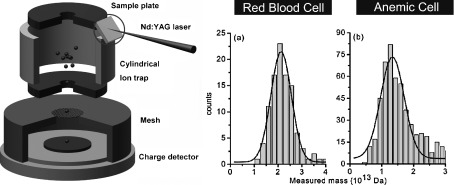
The simplification of chemical analysis by mass spectrometry has advanced significantly in the past decade with the development of ambient ionization methods—methods in which the modified sample is examined in its native unmodified state and which therefore greatly simpler and speeds up analytical measurements on complex samples.52) These qualities of the various methods are widely appreciated but there remains a perception that the ambient ionization methods are not quantitative. That this need not be the case when suitable procedures for adding isotopically labeled internal standards are utilized is illustrated by the following example. Point-of-care measurements of targeted therapeutic drugs in whole blood can be performed using paper spray ionization.53) In this experiment a drop of whole blood is placed on a small paper triangle onto which a small sample of internal standard has previously been added. After addition of the blood a potential is applied and a droplet spray ensues from the wet paper for a few minutes. If the spray is admitted into a mass spectrometer, the relative amounts of analyte and its isotopically labeled internal standard can be measured accurately using a pair of multiple reaction monitoring experiments.
Figure 2 summarizes the results of this experiment by making explicit comparisons with conventional LC/MS/MS. The ambient ionization MS/MS experiment involves sample work up and the data are obtained very rapidly yet. The linear dynamic range and quantitative precision for the anti-cancer drug imatinib are identical to values recorded by the standard LC/MS/MS method.
Fig. 2. Explicit comparison of ambient paper spray MS/MS (left) with conventional LC/MS/MS.54).
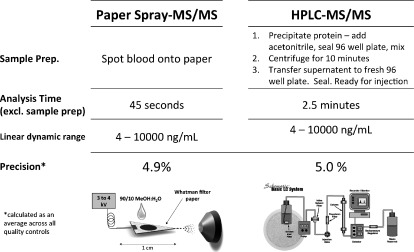
For a decade or so, the use of mass spectrometry, particularly MALDI mass spectrometry, for the chemical imaging of biological tissue has been developing rapidly.55) An alternative to MALDI imaging which does not require addition of a matrix is the spray based ambient ionization of desorption electrospray ionization (DESI).56) DESI is particularly effective at lipid analysis and with appropriate solvents is non-destructive (although based on solvent extraction). This ‘morphologically friendly’ method can be performed without affecting standard histological data and so can be inserted into the normal surgical work-flow. Early data on liver cancer showed the ability to discriminate between healthy and diseased tissue based on their characteristic lipid profiles.57) Subsequent studies on other cancers have confirmed these findings.58) More recently, automated comparisons of DESI spectra with library spectra representative of different types, grades, and cancer cell densities in human brain cancers have been developed. This approach has been tested with banked tissue samples59) and recently with samples from patents undergoing treatment for brain tumors. The results are highly encouraging. The data in Fig. 3 illustrate the approach used and some of the data obtained.
Fig. 3. Classifying human brain tumors by lipid imaging with mass spectrometry. Top: What the pathologist sees: Optical image of the H&E-stained adjacent section. Center: MS-distribution of hundreds of chemicals: Tumor heterogeneity and infiltration is assessed by DESI-MS imaging. Negative ion mode DESI-MS ion images of glioblastoma G33 showing the distribution of PS(36 : 1) at m/z 788 and PS(40 : 6) at m/z 834. Bottom: Classification results can be visualized as a class image using a color code corresponding to each class and registered to the optical image of an adjacent section. Grade and concentration classification for heterogeneous sample G33. Adapted from ref. 59 with permission. © 2012 American Association for Cancer Research.
It should be noted that diagnostic information is obtained from the mass spectrum itself, not from MS/MS data which is useful for identifying the compounds of interest (here phospholipids). This information is valuable in studying the details of biology but so far the MS lipid profiles meet the requirements for diagnostics. A second point about molecular diagnostics performed using mass spectrometry is that only modest spatial resolution is required. The required resolution need not be any greater than that achievable in surgery, and in practice a spot size of 200 μm works well. For intrasurgical applications60) it might be interesting to map in detail the lipid distribution in the local area where tissue resection is planned, but this need not be done using full MS images. The guiding principle will be the time required for the diagnostic measurement. A set of measurements along a line or in a random spot pattern will take much less time and provide almost as much information as a full lipid image.
The potential of mass spectrometry for online reaction monitoring has been realized since the 1960s, but the lack of suitably small instrumentation and of ionization methods of sufficiently wide applicability has limited its development. This has changed recently although the most obvious ionization methods, those based on electrospray ionization, have practical drawbacks including capillary blockage when used for online monitoring. This is especially so when real samples which have high concentrations—synthetic organic reaction mixtures for one example, or whole biofluids as another—must be monitored. Consider the reductive amination reaction61) shown below. To monitor this reaction at realistic (high) concentrations a number of methods were attempted unsuccessfully (namely desorption electrospray ionization mass spectrometry, low temperature plasma mass spectrometry, paper spray mass spectrometry, transmission desorption electrospray ionization mass spectrometry). A variant of ESI, inductive ESI, was successful because in this experiment a direct connection between the voltage source and the solution is not made and because the capillary undergoes ‘self-cleaning’ and the induced voltage changes rapidly as a pulsed DC signal is applied.62) As illustrated in Fig. 4 the reagent, 1, the intermediate 3 and the final product 4, are each readily measured over a long reaction time period. As also indicated in the same figure, it is possible to directly examine biofluids and to couple the inductive ESI source to a miniature mass spectrometer.62a)
Fig. 4. Top: General reaction scheme depicting the reductive amination reaction. Bottom left: Reaction control of the reductive amination reaction using inductive nano ESI: Reagent, 1, the intermediate 3 and the final product 4, are each readily measured over a long reaction time period. Bottom right: Scheme of an induced nanoESI emitter. The electrospray potential (2–4 kV) is applied to an electrode approaching the spray emitter within 2 mm. The applied potential is pulsed repeatedly in the positive mode at a frequency of typically 50 Hz. Strong dynamic electromagnetic fields are produced in the adjacent nESI emitter to result in a burst of nESI droplets.62).
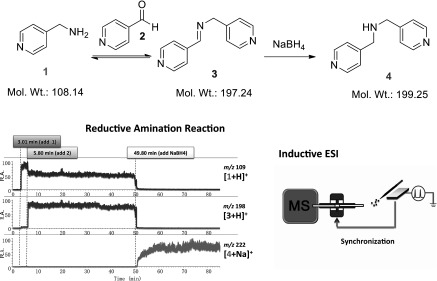
Progress in chemical analysis, such as the examples just discussed, depends on earlier innovation in instrumentation and understanding of the (ion) chemistry involved. A topic of emerging interest in ion chemistry involves monitoring ionic processes outside the vacuum system, viz. exploring reactions of ions in the ambient environment including reactions at surfaces. In such experiments one might use mass analysis to identify reactant ions but then perform the experiment—reagent ion creation, its focusing in air, product ion formation, transmission and collection—without recourse to mass analysis except perhaps in the final stage of product analysis. The immediate aims of such experiments are to explore reactivity under ambient conditions, a long term aim is to scale up the reactions so that they can be used for preparative purposes.
Consider the pyrylium to pyridinium ion conversion studied in solution in detail by Katritzky.63) The reaction, a nucleophilic addition/elimination, can be studied as an ion/surface reactive collision in air by generating the pyrylium ion by electrospray ionization, then removing the solvent by passing the spray through a heated coiled tube. Finally the dry ions are brought through the air to a surface bearing an amine of interest, in this case lysine. Given the high pressure, the collision energy is necessarily low. Note also that the ambient surface is covered with adsorbates, including water. Nevertheless, the reaction occurs readily as shown by the data of Fig. 5; which displays mass spectra recorded on the reactively scattered product ions.
Fig. 5. Left: General reaction scheme depicting the heterogeneous Katritzky reaction. Right: Schematic representation of atmospheric pressure ion/surface reactions between 2,4,6-triphenyl-pyrylium cations impinging on a surface bearing d-Lysine. Mass spectra were recorded in the positive and negative ion modes for each soft-landed chemical species. Adapted from ref. 64 with permission. © 2011 American Chemical Society.
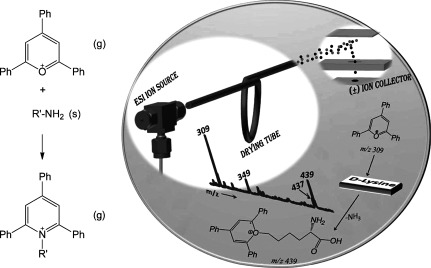
A remarkable feature of reactivity in solutions of limited volumes is that rates are accelerated. This was first shown in mass spectrometry for the microdroplets produced by DESI experiments in which a reagent was included in the spray solvent (‘reactive DESI’). The reaction rates were observed to be increased by some orders of magnitude over those seen in the same compounds in bulk solution.65) Clearly, there is an increase in concentration of reagents as the droplets evaporate together with a corresponding increase (basic solution) or decrease (acidic solution) in pH. It has been argued65) that the concentration and pH effects might not alone explain the observed behavior and that intrinsic factors (intertwining of reagents, wall effects, etc.) may increase rate constants beyond those associated with concentration effects. These effects are seen in DESI experiments and also in paper spray experiments. The details of the phase and timing of the reactions are not known, but the fact of rate increase is evident in comparisons with solution-phase reactions. Another example is shown by the Katritsky reaction on paper (Fig. 6).
Fig. 6. Katritsky pyrylium reaction performed online using paper spray ionization mass spectrometry. Different reaction rates are indicated by different mass spectrometric signal intensities of product and reactant. Left top: General reaction scheme depicting the Katritsky reaction. Right top: Comparison of the reaction rates in bulk solution vs. reaction in droplets arising from paper spray ionization. Left bottom: Intercharge distance effects. Right bottom: Substituents effects.66).
In this example the reaction on paper is 99% complete at the shortest measurement time, 30 s, while the solution reaction is only 10% complete after 36 min, both judged by peak heights in the mass spectrum. The data of Fig. 6 include substituent effects which are consistent with the expectation of nucleophilic rate control. The data also include the effects of alkyl chain length which show that coulombic repulsion inhibits formation of products with short alkyl connecting units.
The effects of accelerated reaction rates in evaporating droplets means that experiments in which the contents of solutions are examined by mass spectrometry need to be interpreted with care. Such experiments have given useful information on the state of a chemical system when performed by ESI67) and the DESI experiment has become a significant source of information on reaction intermediates in transition metal catalyzed reactions.68) Recent data suggests that the amount of material in the initially formed droplet (i.e. the product of its size and the concentration) will determine whether ESI will provide analytical information on the components of a mixture being sampled or whether those components will react to generate products. Larger droplets and low concentrations seem likely to give the usual analytical data. Higher concentrations and smaller droplets appear to favor chemical reaction, where this is possible.
The connections between reactions occurring under conventional solution-phase conditions and those that occur in restricted volumes are vividly shown by the case of the Mannich reaction. The β-keto amine formation reaction involves three reagents which are brought together in a solution that is dropcast onto a surface (Fig. 7). Reaction apparently occurs in the thin film just before evaporation to dryness although the details of the mechanism remain to be elucidated.
Fig. 7. Top: General reaction scheme depicting the Mannich reaction. Bottom: Nanospray-MS of a reaction mixture of 33 mM piperidine and 28 mM acrylamide after 1 h bulk solution-phase reaction (left), and 10 min surface reaction (right). In both cases 2 μL of each reagent in acetonitrile was used without catalyst. After 10 min reaction time, the surface reaction mixture was dissolved in 10 μL of methanol–water (1 : 1, vol/vol) and analyzed using nanospray ionization (1.8 kV; left spectrum). Similarly, after 1 h bulk-phase reaction, 10 μL of methanol–water (1 : 1, vol/vol) was added to the reaction mixture for MS analysis (right spectrum). Adapted from ref. 69 with permission. © 2012 Springer Science+Business Media.
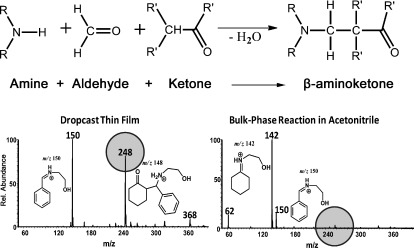
Yet another example is found in the case of the base-catalyzed Claisen–Schmidt condensation of an aldehyde and an aryl ketone in strong base (Fig. 8). In this case the interest extended to scaling up the reaction and this was done by operating four electrosprays in parallel to achieve product formation in a yield of 92% at a rate of about 1 mg/min. Clearly this amount of material has begun to resemble ordinary microscale synthesis. A spray being used for synthesis can be analyzed online but it is usually sufficient to do this a one or a few points during the synthesis and then to spray onto a high surface area material where product collects. Final off-line analysis by mass spectrometry or other spectroscopic method can be used for product analysis.
Fig. 8. Preparative electrospray of a base-catalyzed Claisen–Schmidt condensation of 1-indanone and 4-chlorobenzaldehyde. Top: Setup for synthesis using an array of four multiplexed ESSI sprayer tips (scheme, polypropylene vessel bottom sealed with glass wool and silica material, array of four ESSI sprayer tips). A solution of 0.83 mg of 1-indanone, 0.88 mg of 4-chlorobenzaldehyde and catalytic amounts of KOH was electrosprayed within 2.5 min and gave 1.47±0.09 mg or 92.2% of the main product. Bottom: Reaction scheme. Adapted from ref. 70 with permission. © 2012 Wiley-VCH Verlag GmbH and Co. KGaA, Weinheim.
Figure 9 shows more detailed analysis of the reaction product of base-catalyzed Claisen–Schmidt condensation of 1-indanone and 4-chlorobenzaldehyde. Simple UV/Vis spectra show that even after 60 min of reaction under normal bulk reaction conditions product formation is incomplete, while the virtually instantaneous preparative ESI experiment product formation is complete to the extent that this measurement can determine. HPLC experiments confirmed these findings, with little reaction in the bulk solution after 15 min and extensive reaction by preparative MS. While more than 90% conversion to products occurs in the latter experiments, the by-products are interesting too, corresponding to products of further reaction of the main product as illustrated in Fig. 9.
Fig. 9. Product analyses of a base-catalyzed Claisen–Schmidt condensation of 1-indanone and 4-chlorobenzaldehyde (for reaction scheme see Fig. 8). Top left (UV): Reactions in bulk solution after 60 min (solid line) and in a preparative electrospray after 10 min of spraying. Bottom left (HPLC): HPLC analysis of reactions in bulk solution (top) and in a preparative electrospray (bottom). Right (MS): APCI-MS spectra of the main product 4 (top) and the side product 9 (center) as well as the side product 10 (bottom) obtained from a preparative electrospray experiment. The insets show the corresponding structural formulae. Adapted from ref. 70 with permission. © 2012 Wiley-VCH Verlag GmbH and Co. KGaA, Weinheim.
EXPANSIVE FUTURE
It is already clear that MS has a role in diagnostics and in clinical chemistry. Direct quantitative analysis of whole blood by the ambient ionization method of paper spray is a demonstrated capability for therapeutic drugs at biologically relevant levels with performance characteristics comparable to LC/MS/MS. Diagnosis using characteristic lipid profiles allows diseased tissue to be distinguished from healthy tissue. When will such experiments be used intrasurgically? The requirements include automated correlations of the MS data with spectral libraries and reduction in the size of the instrument, but the fact that the measurements can already be made on unmodified tissue suggests that significant impact on pathology and surgery lies ahead.
If one can make ions in air can one detect them in air? Mass analyze them in air? Can the worst performance parameter of the mass spectrometer—the ionization efficiency—be significantly improved? Can atomic probe measurements be coupled with mass spectrometry to characterize biological ions on surfaces? Alternatively, can the physical and chemical properties of trapped macro-ions be characterized? A beginning has been made using fluorescence resonance energy transfer, electron diffraction and precise thermochemical measurements in the ion trap.
Surely MS could make a much larger contribution to chiral analysis—through ion/molecule reactions or the kinetic method. Will multi-array format mass spectrometers take their place beside single-channel instruments? Finally, perhaps most importantly, does the mass spectrometer have a role in the everyday life of people at large—as a personal and household measurement device? (Fig. 10) The development of ambient ionization sources and especially their coupling to handheld miniature mass spectrometers71) clearly prefaces such possibilities.
Fig. 10. Picture of a wearable miniature mass spectrometer.72).
The stage seems to be set for the rapid development of mass spectrometry as a synthetic tool. Clearly microscale organic reactions can be performed to give pure products in relatively short periods of time. The experimental arrangement lends itself perfectly to array synthesis. The experiment could easily be extended to cover biological reactions including drug candidate/target reactions. The formation of products can be examined online using the methods of desorption ionization or by conventional off-line methods including mass spectrometry. Complete experiments could be used to determine relative activity based on competitive binding.
Just as interesting as these small scale high diversity experiments would be the scale up of reactions to a much larger scale, e.g. the gram scale. One possible example of this chemistry is derivatization of waxes by nitrogen atom insertion, the reagent being N3+ and being derived from nitrogen in air using a continuous electrical discharge.73)
Acknowledgments
Many people contributed to the work described from our laboratories and their names appear in the references cited. Acknowledgement of financial support is made to the National Science Foundation (CHE 0848650), the US Department of Energy, Basic Energy Sciences, Separations and Analysis program DE-FG02-06ER15807 and the AMI Institute for Biomedical Development at Purdue University.
References
- 1) (a) W. Wien. Untersuchungen über die elektrische Entladung in verdünnten Gasen. Annalen d. Phys. 301: 440–452, 1898 [Google Scholar]
- (b) J. J. Thomson. LXIV. On the emission of negative corpuscles by the alkali metals. Philosophical Magazine Series 6 10: 584–590, 1905 [Google Scholar]
- 2) J. J. Thomson. Rays of Positive Electricity and Their Application to Chemical Analysis, Longmans, Green & Co., London, 1913
- 3) A. O. Nier. Variations in the relative abundances of the isotopes of common lead from various sources. J. Am. Chem. Soc. 60: 1571–1576, 1938 [Google Scholar]
- 4) F. W. Aston. LXXIV. A positive ray spectrograph. Philosophical Magazine Series 6 38: 707–714, 1919 [Google Scholar]
- 5) F. H. Field, J. L. Franklin. Electron Impact Phenomena and the Properties of Gaseous Ions, Academic Press, Inc., New York, 1957
- 6) F. W. McLafferty. Mass spectrometric analysis—Aliphatic ethers. Anal. Chem. 29: 1782–1789, 1957 [Google Scholar]
- 7) D. P. Stevenson. Ionization and dissociation by electronic impact. The ionization potentials and energies of formation of sec-propyl and tert-butyl radicals. Some limitations on the method. Discuss. Faraday Soc. 10: 35–45, 1951 [Google Scholar]
- 8) (a) J. H. Beynon. Mass Spectrometry and Its Application to Organic Chemistry, Elsevier, Amsterdam, 1960
- (b) H. Budzikiewicz, C. Djerassi, D. H. Williams. Mass Spectrometry of Organic Compounds, Holden-Day, San Francisco, 1967
- (c) K. Biemann. Four decades of structure determination by mass spectrometry: From alkaloids to heparin. J. Am. Soc. Mass Spectrom. 13: 1254–1272, 2002 [DOI] [PubMed] [Google Scholar]
- 9) (a) R. Ryhage. The Mass Spectrometry Laboratory at the Karolinska Institute 1944–1987. Mass Spectrom. Rev. 12: 1–49, 1993 [Google Scholar]
- (b) R. S. Gohlke. Time-of-flight mass spectrometry and gas–liquid partition chromatography. Anal. Chem. 31: 535–541, 1959 [Google Scholar]
- (c) E. Gelpí. From large analogical instruments to small digital black boxes: 40 years of progress in mass spectrometry and its role in proteomics. Part I 1965–1984. J. Mass Spectrom. 43: 419–435, 2008 [DOI] [PubMed] [Google Scholar]
- 10) T. Matsuo, Y. Seyama. Introduction to Modern Biological Mass Spectrometry. in Biological Mass Spectrometry Present and Future (Ed: T. Matsuo, R. M. Caprioli, M. L. Gross, Y. Seyama), John Wiley & Sons, Chichester, 1994
- 11) W. C. Wiley, I. H. McLaren. Time‐of‐flight mass spectrometer with improved resolution. Rev. Sci. Instrum. 26: 1150–1157, 1955 [Google Scholar]
- 12) W. Paul, H. Steinwedel. Ein neues Massenspektrometer ohne Magnetfeld. Z. Naturforschung 8a: 448–450, 1953
- 13) (a) H. D. Beckey. A new rule concerning comparative interpretation of electron impact and field ionization mass spectra. Int. J. Mass Spectrom. Ion Phys. 1: 93–97, 1968 [Google Scholar]
- (b) M. Barber, R. S. Bordoli, R. D. Sedgwick, A. N. Tyler. Fast atom bombardment of solids (F.A.B.): A new ion source for mass spectrometry. J. Chem. Soc., Chem. Commun. 325–327, 1981 [Google Scholar]
- (c) R. D. Macfarlane, D. F. Torgerson. Californium-252 plasma desorption mass spectroscopy. Science 191: 920–925, 1976 [DOI] [PubMed] [Google Scholar]
- 14) (a) J. B. Fenn, M. Mann, C. K. Meng, S. F. Wong, C. M. Whitehouse. Electrospray ionization for mass spectrometry of large biomolecules. Science 246: 64–71, 1989 [DOI] [PubMed] [Google Scholar]
- (b) J. B. Fenn, M. Mann, C. K. Meng, S. F. Wong, C. M. Whitehouse. Electrospray ionization—Principles and practice. Mass Spectrom. Rev. 9: 37–70, 1990 [Google Scholar]
- 15) (a) W. H. McFadden, R. Teranishi, J. Corse, D. R. Black, T. R. Mon. Volatiles from strawberries: II. Combined mass spectrometry and gas chromatography on complex mixtures. J. Chromatogr. A 18: 10–19, 1965 [DOI] [PubMed] [Google Scholar]
- (b) C. R. Blakley, M. L. Vestal. Thermospray interface for liquid chromatography/mass spectrometry. Anal. Chem. 55: 750–754, 1983 [Google Scholar]
- 16) (a) R. W. Kondrat, R. G. Cooks. Direct analysis of mixtures by mass spectrometry. Anal. Chem. 50: 81A–92A, 1978. [Google Scholar]
- (b) F. W. McLafferty. Tandem Mass Spectrometry, John Wiley & Sons, New York, 1983
- 17) D. F. Hunt, W. M. Bone, J. Shabanowitz, J. Rhodes, J. M. Ballard. Sequence analysis of oligopeptides by secondary ion/collision activated dissociation mass spectrometry. Anal. Chem. 53: 1704–1706, 1981 [Google Scholar]
- 18) (a) V. L. Tal’roze, A. K. Lyubimova. Dokl. Akad. Nauk SSSR 86: 909, 1952 [Google Scholar]
- (b) V. L. Tal’roze, A. K. Ljubimova. Secondary Processes in the Ion Source of a Mass Spectrometer (Presented by academician N. N. Semenov 27 VIII 1952) Èreprinted from Report of the Soviet Academy of Sciences, Volume LXXXVI, -N5 (1952). J. Mass Spectrom. 33, 1998 [Google Scholar]
- 19) C. R. Moylan, J. I. Brauman. Gas phase acid-base chemistry. Annu. Rev. Phys. Chem. 34: 187–215, 1983 [Google Scholar]
- 20) H. M. Rosenstock, M. B. Wallenstein, A. L. Wahrhaftig, H. Eyring. Absolute rate theory for isolated systems and the mass spectra of polyatomic molecules. Proc. Natl. Acad. Sci. U.S.A. 38: 667–678, 1952 [DOI] [PMC free article] [PubMed] [Google Scholar]
- 21) R. G. Cooks, D. W. Setser, K. Jennings, S. Jones. Energy partition in the fragmentation of organic ions: Benzaldoxime methyl ethers. Int. J. Mass Spectrom. Ion Phys. 7: 493–496, 1971 [Google Scholar]
- 22) A. K. Shukla, K. Qian, S. L. Howard, S. G. Anderson, K. W. Sohlberg, J. H. Futrell. Collision-induced dissociation reaction dynamics of the acetone molecular ion. Int. J. Mass Spectrom. Ion Process. 92: 147–169, 1989 [Google Scholar]
- 23) (a) G. E. Johnson, Q. Hu, J. Laskin. Soft landing of complex molecules on surfaces. Annu. Rev. Anal. Chem. (Palo Alto, Calif.) 4: 83–104, 2011 [DOI] [PubMed] [Google Scholar]
- (b) J. Cyriac, T. Pradeep, H. Kang, R. Souda, R. G. Cooks. Low-energy ionic collisions at molecular solids. Chem. Rev.2012 [DOI] [PubMed]
- 24) (a) J. J. Thomson. Cathode rays. Philos. Mag. 44: 293–316, 1897 [Google Scholar]
- (b) J. J. Thomson. On rays of positive electricity. Phil. Mag. Series 613 (77): 561–575, 1907 [Google Scholar]
- 25) W. Wien. Kanalstrahlen. in Handbuch der Radiologie Vol. IV (Ed: E. Marx), Leipzig, 1917 [Google Scholar]
- 26) (a) E. Minaya Ramirez, D. Ackermann, K. Blaum, M. Block, C. Droese, Ch. E. Düllmann, M. Dworschak, M. Eibach, S. Eliseev, E. Haettner, F. Herfurth, F. P. Heßberger, S. Hofmann, J. Ketelaer, G. Marx, M. Mazzocco, D. Nesterenko, Y. N. Novikov, W. R. Plaß, D. Rodríguez, C. Scheidenberger, L. Schweikhard, P. G. Thirolf, C. Weber. Direct mapping of nuclear shell effects in the heaviest elements. Science 337: 1207–1210, 2012 [DOI] [PubMed] [Google Scholar]
- (b) L. Chen, W. R. Plass, H. Geissel, R. Knoebel, C. Kozhuharov, Y. A. Litvinov, Z. Patyk, C. Scheidenberger, K. Siegien-Iwaniuk, B. Sun, H. Weick, K. Beckert, P. Beller, F. Bosch, D. Boutin, L. Caceres, J. J. Carroll, D. M. Cullen, I. J. Cullen, B. Franzke, J. Gerl, M. Górska, G. A. Jones, A. Kishada, J. Kurcewicz, S. A. Litvinov, Z. Liu, S. Mandal, F. Montes, G. Muenzenberg, F. Nolden, T. Ohtsubo, Z. Podolyák, R. Propri, S. Rigby, N. Saito, T. Saito, M. Shindo, M. Steck, P. M. Walker, S. Williams, M. Winkler, H. J. Wollersheim, T. Yamaguchi. New results on mass measurements of stored neutron-rich nuclides in the element range from Pt to U with the FRS-ESR facility at 360–400 MeV/u. Nucl. Phys. A 882: 71–89, 2012 [Google Scholar]
- 27) S. A. McLuckey, J. L. Stephenson Jr. Ion/ion chemistry of high-mass multiply charged ions. Mass Spectrom. Rev. 17: 369–407, 1998 [DOI] [PubMed] [Google Scholar]
- 28) A. Božović, S. Feil, G. K. Koyanagi, A. A. Viggiano, X. Zhang, M. Schlangen, H. Schwarz, D. K. Bohme. Conversion of methane to methanol: Nickel, palladium, and platinum (d9) cations as catalysts for the oxidation of methane by ozone at room temperature. Chemistry 16: 11605–11610, 2010 [DOI] [PubMed] [Google Scholar]
- 29) (a) E. W. McDaniel. Collision Phenomena in Ionized Gases, John Wiley & Sons, Inc., New York, 1964
- (b) E. R. Badman, C. S. Hoaglund-Hyzer, D. E. Clemmer. Monitoring structural changes of proteins in an ion trap over approximately 10–200 ms: Unfolding transitions in cytochrome c ions. Anal. Chem. 73: 6000–6007, 2001 [DOI] [PubMed] [Google Scholar]
- 30) J. H. Beynon, R. A. Saunders, A. E. Williams. Dissociation of meta-stable ions in mass spectrometers with release of internal energy. Z. Naturforsch. A 22: 180, 1967 [Google Scholar]
- 31) W. A. Chupka, E. Lindholm. Dissociation of butane molecular ions formed in charge exchange collisions with positive ions. Ark. Fys. 25: 349–361, 1963 [Google Scholar]
- 32) K. R. Ryan, J. H. Futrell. Effect of translational energy on ion—Molecule reaction rates. II. J. Chem. Phys. 43: 3009–3014, 1965 [Google Scholar]
- 33) N. Goldberg, H. Schwarz. Neutralization-reionization mass spectrometry: A powerful “laboratory” to generate and probe elusive neutral molecules. Acc. Chem. Res. 27: 347–352, 1994 [Google Scholar]
- 34) S. A. Sullivan, B. S. Freiser, J. L. Beauchamp. Gas phase photodissociation spectrum of Cl-2. Chem. Phys. Lett. 48: 294–298, 1977 [Google Scholar]
- 35) P. Jena, A. W. Castleman Jr. Clusters: A bridge across the disciplines of physics and chemistry. Proc. Natl. Acad. Sci. U.S.A. 103: 10560–10569, 2006 [DOI] [PMC free article] [PubMed] [Google Scholar]
- 36) B. S. Freiser. Special feature: Tutorial gas-phase metal ion chemistry. J. Mass Spectrom. 31: 703–715, 1996 [Google Scholar]
- 37) (a) M. Karas, F. Hillenkamp. Laser desorption ionization of proteins with molecular masses exceeding 10,000 daltons. Anal. Chem. 60: 2299–2301, 1988 [DOI] [PubMed] [Google Scholar]
- (b) K. Tanaka, H. Waki, Y. Ido, S. Akita, Y. Yoshida, T. Yoshida, T. Matsuo. Protein and polymer analysis up to m/z 100,000 by laser ionization time-of-flight mass spectrometry. Rapid Commun. Mass Spectrom. 2: 151–153, 1988 [Google Scholar]
- 38) D. F. Torgerson, R. P. Skowronski, R. D. Macfarlane. New approach to the mass spectroscopy of non-volatile compounds. Biochem. Biophys. Res. Commun. 60: 616–621, 1974 [DOI] [PubMed] [Google Scholar]
- 39) L. K. Liu, K. L. Busch, R. G. Cooks. Matrix-assisted secondary ion mass spectra of biological compounds. Anal. Chem. 53: 109–113, 1981 [Google Scholar]
- 40) R. A. Yost, C. G. Enke. Selected ion fragmentation with a quadrupole mass spectrometer. J. Am. Chem. Soc. 100: 2274–2275, 1978 [Google Scholar]
- 41) J. N. Louris, R. G. Cooks, J. E. P. Syka, P. E. Kelley, G. C. Stafford, J. F. J. Todd. Instrumentation, applications, and energy deposition in quadrupole ion-trap tandem mass spectrometry. Anal. Chem. 59: 1677–1685, 1987 [Google Scholar]
- 42) (a) C. G. Enke, A. P. Wade, P. T. Palmer, K. J. Hart. Solving the Ms Ms puzzle—Strategies for automated structure elucidation. Anal. Chem. 59: 1363A–1371A, 1987 [Google Scholar]
- (b) K. L. Busch, G. L. Glish, S. A. McLuckey. Mass Spectrometry/Mass Spectrometry: Techniques and Applications of Tandem Mass Spectrometry, VCH, New York, 1988
- 43) J. C. Schwartz, A. P. Wade, C. G. Enke, R. G. Cooks. Systematic delineation of scan modes in multidimensional mass spectrometry. Anal. Chem. 62: 1809–1818, 1990 [DOI] [PubMed] [Google Scholar]
- 44) V. Lange, P. Picotti, B. Domon, R. Aebersold. Selected reaction monitoring for quantitative proteomics: A tutorial. Mol. Syst. Biol. 4: 222, 2008 [DOI] [PMC free article] [PubMed] [Google Scholar]
- 45) F. W. Aston. Neon. Nature104: 334, 1919 [Google Scholar]
- 46) (a) J. Mattauch, R. Herzog. Über einen neuen Massenspektrographen. Z. Phys. 89: 786–795, 1934 [Google Scholar]
- (b) E. G. Johnson, A. O. Nier. Angular aberations in sector-shaped electromagnetic lenses for focusing beams of charged particles. Phys. Rev. 91: 10–17, 1953 [Google Scholar]
- 47) D. O. Schissler, D. P. Stevenson. The benzyl–hydrogen bond dissociation energy from electron impact measurements. J. Chem. Phys. 22: 151–152, 1954 [Google Scholar]
- 48) J. A. Hipple, E. U. Condon. Detection of metastable ions with the mass spectrometer. Phys. Rev. 68: 54–55, 1945 [Google Scholar]
- 49) P. Kebarle, E. W. Godbole. Mass-spectrometric study of ions from the α-particle irradiation of gases at near atmospheric pressures. J. Chem. Phys. 39: 1131–1132, 1963 [Google Scholar]
- 50) J. I. Brauman, L. K. Blair. Gas-phase acidities of alcohols. J. Am. Chem. Soc. 92: 5986–5992, 1970 [Google Scholar]
- 51) C. Xiong, G. Xu, X. Zhou, J. Wang, Y. Tang, R. Chen, W. P. Peng, H. C. Chang, Z. Nie. The development of charge detection-quadrupole ion trap mass spectrometry driven by rectangular and triangular waves. Analyst (Lond.) 137: 1199–1204, 2012 [DOI] [PubMed] [Google Scholar]
- 52) (a) G. A. Harris, A. S. Galhena, F. M. Fernández. Ambient sampling/ionization mass spectrometry: Applications and current trends. Anal. Chem. 83: 4508–4538, 2011 [DOI] [PubMed] [Google Scholar]
- (b) P. Nemes, A. Vertes. Ambient mass spectrometry for in vivo local analysis and in situ molecular tissue imaging. TrAC Trends Analyt. Chem. 34: 22–34, 2012 [Google Scholar]
- (c) C. Wu, A. L. Dill, L. S. Eberlin, R. G. Cooks, D. R. Ifa. Mass spectrometry imaging under ambient conditions. Mass Spectrom. Rev. n/a, 2012 [DOI] [PMC free article] [PubMed] [Google Scholar]
- 53) R. G. Cooks, N. E. Manicke, A. L. Dill, D. R. Ifa, L. S. Eberlin, A. B. Costa, H. Wang, G. Huang, Z. Ouyang. New ionization methods and miniature mass spectrometers for biomedicine: DESI imaging for cancer diagnostics and paper spray ionization for therapeutic drug monitoring. Faraday Discuss. 149: 247–267, discussion, 333–356, 2011 [DOI] [PMC free article] [PubMed] [Google Scholar]
- 54) We thank Dr. Nick Manicke for this data.
- 55) P. Chaurand, D. S. Cornett, R. M. Caprioli. Molecular imaging of thin mammalian tissue sections by mass spectrometry. Curr. Opin. Biotechnol. 17: 431–436, 2006 [DOI] [PubMed] [Google Scholar]
- 56) (a) Z. Takáts, J. M. Wiseman, B. Gologan, R. G. Cooks. Mass spectrometry sampling under ambient conditions with desorption electrospray ionization. Science 306: 471–473, 2004 [DOI] [PubMed] [Google Scholar]
- (b) R. G. Cooks, Z. Ouyang, Z. Takáts, J. M. Wiseman. Detection technologies. Ambient mass spectrometry. Science 311: 1566–1570, 2006 [DOI] [PubMed] [Google Scholar]
- 57) E. H. Seeley, R. M. Caprioli. Imaging mass spectrometry: Towards clinical diagnostics. Proteomics Clin. Appl. 2: 1435–1443, 2008 [DOI] [PubMed] [Google Scholar]
- 58) (a) A. L. Dill, L. S. Eberlin, A. B. Costa, C. Zheng, D. R. Ifa, L. A. Cheng, T. A. Masterson, M. O. Koch, O. Vitek, R. G. Cooks. Multivariate statistical identification of human bladder carcinomas using ambient ionization imaging mass spectrometry. Chemistry 17: 2897–2902, 2011 [DOI] [PMC free article] [PubMed] [Google Scholar]
- (b) A. L. Dill, L. S. Eberlin, C. Zheng, A. B. Costa, D. R. Ifa, L. A. Cheng, T. A. Masterson, M. O. Koch, O. Vitek, R. G. Cooks. Multivariate statistical differentiation of renal cell carcinomas based on lipidomic analysis by ambient ionization imaging mass spectrometry. Anal. Bioanal. Chem. 398: 2969–2978, 2010 [DOI] [PMC free article] [PubMed] [Google Scholar]
- (c) L. S. Eberlin, A. L. Dill, A. B. Costa, D. R. Ifa, L. Cheng, T. Masterson, M. Koch, T. L. Ratliff, R. G. Cooks. Cholesterol sulfate imaging in human prostate cancer tissue by desorption electrospray ionization mass spectrometry. Anal. Chem. 82: 3430–3434, 2010 [DOI] [PMC free article] [PubMed] [Google Scholar]
- 59) L. S. Eberlin, I. Norton, A. L. Dill, A. J. Golby, K. L. Ligon, S. Santagata, R. G. Cooks, N. Y. R. Agar. Classifying human brain tumors by lipid imaging with mass spectrometry. Cancer Res. 72: 645–654, 2012 [DOI] [PMC free article] [PubMed] [Google Scholar]
- 60) K.-C. Schäfer, J. Dénes, K. Albrecht, T. Szaniszló, J. Balog, R. Skoumal, M. Katona, M. Tóth, L. Balogh, Z. Takáts. In vivo, in situ tissue analysis using rapid evaporative ionization mass spectrometry. Angew. Chem. Int. Ed. Engl. 48: 8240–8242, 2009 [DOI] [PubMed] [Google Scholar]
- 61) B. A. Wong, S. Friedle, S. J. Lippard. Solution and fluorescence properties of symmetric dipicolylamine-containing dichlorofluorescein-based Zn2+ sensors. J. Am. Chem. Soc. 131: 7142–7152, 2009 [DOI] [PMC free article] [PubMed] [Google Scholar]
- 62) (a) G. Huang, G. Li, J. Ducan, Z. Ouyang, R. G. Cooks. Synchronized inductive desorption electrospray ionization mass spectrometry. Angew. Chem. Int. Ed. Engl. 50: 2503–2506, 2011 [DOI] [PubMed] [Google Scholar]
- (b) G. Huang, G. Li, R. G. Cooks. Induced nanoelectrospray ionization for matrix-tolerant and high-throughput mass spectrometry. Angew. Chem. Int. Ed. Engl.50: 9907–9910, 2011 [DOI] [PubMed] [Google Scholar]
- 63) A. R. Katritzky. Conversions of primary amino groups into other functionality mediated by pyrylium cations. Tetrahedron 36: 679–699, 1980 [Google Scholar]
- 64) A. K. Badu-Tawiah, C. Wu, R. G. Cooks. Ambient ion soft landing. Anal. Chem. 83: 2648–2654, 2011 [DOI] [PubMed] [Google Scholar]
- 65) M. Girod, E. Moyano, D. I. Campbell, R. G. Cooks. Accelerated bimolecular reactions in microdroplets studied by desorption electrospray ionization mass spectrometry. Chem. Sci. 2: 501–510, 2011 [Google Scholar]
- 66) X. Yan. unpublished data.
- 67) (a) A. A. Sabino, A. H. Machado, C. R. Correia, M. N. Eberlin. Probing the mechanism of the Heck reaction with arene diazonium salts by electrospray mass and tandem mass spectrometry. Angew. Chem. Int. Ed. Engl. 43: 2514–2518, 2004 [DOI] [PubMed] [Google Scholar]
- (b) C. A. Marquez, F. Fabbretti, J. O. Metzger. Electrospray ionization mass spectrometric study on the direct organocatalytic alpha-halogenation of aldehydes. Angew. Chem. Int. Ed. Engl. 46: 6915–6917, 2007 [DOI] [PubMed] [Google Scholar]
- 68) R. H. Perry, M. Splendore, A. Chien, N. K. Davis, R. N. Zare. Detecting reaction intermediates in liquids on the millisecond time scale using desorption electrospray ionization. Angew. Chem. Int. Ed. Engl. 50: 250–254, 2011 [DOI] [PubMed] [Google Scholar]
- 69) A. K. Badu-Tawiah, D. I. Campbell, R. G. Cooks. Accelerated C–N bond formation in dropcast thin films on ambient surfaces. J. Am. Soc. Mass Spectrom. 23: 1461–1468, 2012 [DOI] [PubMed] [Google Scholar]
- 70) T. Müller, A. Badu-Tawiah, R. G. Cooks. Accelerated carbon–carbon bond-forming reactions in preparative electrospray. Angew. Chem. Int. Ed. 2012. DOI: 10.1002/anie.201206632. [DOI] [PubMed] [Google Scholar]
- 71) Z. Ouyang, R. J. Noll, R. G. Cooks. Handheld miniature ion trap mass spectrometers. Anal. Chem. 81: 2421–2425, 2009 [DOI] [PubMed] [Google Scholar]
- 72) P. I. Hendricks. unpublished.
- 73) G. Li, X. Li, Z. Ouyang, R. G. Cooks. submitted for publication.



